A Visualized Analysis of the Research Current Hotspots and Trends on Innovation Chain Based on the Knowledge Map
Abstract
:1. Introduction
2. Data Sources and Experimental Methods
2.1. Data Sources
2.2. Experimental Methods
3. Data Analysis and Results
3.1. The Co-Author Network of China
3.2. Analysis of Domestic Research Hotspots
3.3. Network Analysis of Important International Core Journals
3.4. Analysis of Important Foreign Authors
3.5. Analysis of Foreign Research Hotspots and Frontiers in the Field of Innovation Chain
4. Summary and Outlook
4.1. Chinese Research Conclusions
4.2. Conclusions from International Studies
4.3. Outlook
Author Contributions
Funding
Institutional Review Board Statement
Informed Consent Statement
Data Availability Statement
Conflicts of Interest
References
- Li, J.; Chen, C. CiteSpace: Scientific Text Mining and Visualization; Beijing University of Economics and Business Press: Beijing, China, 2016; Volume 2. [Google Scholar]
- Chen, C. IBEKWE—SANJUAN, FIDELIA HOU JIANHUA. The structure and dynamics of cogitation clusters: A multiple-perspective co-citation analysis. J. Am. Soc. Inf. Sci. Technol. 2010, 61, 1386–1409. [Google Scholar] [CrossRef] [Green Version]
- Zhang, J. Pzotential growth rate of structural economy: Theoretical reconstruction, overall judgment and reform direction. J. Nanjing Univ. 2020, 57, 38–55. [Google Scholar]
- Li, Y.; Zhou, Y.; Wang, H.; Yu, L. Review and prospect of the integration of industrial innovation chain and service chain. Sci. Manag. Res. 2018, 36, 25–27. [Google Scholar]
- Wang, C.; Xu, H.; Dong, K.; Fang, S. Analysis framework and Application of industrial competitive intelligence based on innovation chain: A case study of Genetic engineering vaccine industry in China. Inf. Theory Pract. 2018, 41, 87–93. [Google Scholar]
- Wang, C.; Dong, K.; Xu, H.; Fang, S. Research on the demand and service strategy of industrial competitive intelligence in the context of innovation-driven development. Mod. Inf. 2017, 37, 16–23. [Google Scholar]
- Liu, Z. From global value chain to global innovation chain: A new driving force for China’s industrial development under the New Normal. Acad. Mon. 2015, 47, 5–14. [Google Scholar]
- Yang, Z.; Li, J.; Wu, Q. Research on innovation chain: Connotation, Effect and direction. J. Nanjing Univ. 2019, 56, 62–70, 159. [Google Scholar]
- Liu, Z.; Yao, Z.; Wu, L. Research on strengthening China’s division of labor in the process of global industrial chain restructuring. Economist 2020, 4, 51–57. [Google Scholar]
- Huang, Y.; Wei, G.; Li, H. A study on strategic emerging Industry’s exclusive alliance and standardization strategy. Science and Technology. Sci. Manag. Res. 2013, 33, 170–173. [Google Scholar]
- Wu, S.; Gong, Y.; Liu, D. Research on collaborative innovation of strategic emerging industries from the perspective of knowledge innovation chain. Sci. Technol. Prog. Countermeas. 2014, 31, 50–55. [Google Scholar]
- Liu, D.; Xie, H.; Zheng, S. Global value chain embedment, innovation driving and China’s manufacturing upgrading. J. Int. Bus. Econ. 2021, 3, 17–32. [Google Scholar]
- Zhang, Q.; Gu, Y. Link and synergy: The internal logic of the “Four Chains” of industry-education integration. J. Natl. Inst. Educ. Adm. 2021, 4, 48–56. [Google Scholar]
- Ghisellini, P.; Cialani, C.; Ulgiati, S. A review on circular economy: The expected transition to a balanced interplay of environmental and economic systems. J. Clean. Prod. 2016, 114, 11–32. [Google Scholar] [CrossRef]
- Bocken, N.M.P.; Short, S.W.; Rana, P. A literature and practice review to develop sustainable business model archetypes. J. Clean. Prod. 2001, 2, 42–56. [Google Scholar] [CrossRef] [Green Version]
- Abdullah, M.; Zailani, S.; Iranmanesh, M. Barriers to green innovation initiatives among manufacturers: The Malaysian case. Rev. Manag. Sci. 2016, 10, 683–709. [Google Scholar] [CrossRef]
- Geissdoerfer, M.; Savaget, P.; Bocken, N.M.P. The Circular Economy A new sustainability paradigm? J. Clean. Prod. 2017, 2, 757–768. [Google Scholar] [CrossRef] [Green Version]
- Su, D.; Wu, Z.; Liu, C. The Research Trend and Research Frontiers of International Technological Innovation Based on Knowledge Map. Sci. Technol. Prog. Countermeas. 2016, 33, 148–155. [Google Scholar]
- Tan, J.; Zhang, H.; Lin, R. Simulation and case study on dynamic Evolution mechanism of industrial innovation network. J. Manag. Sci. 2019, 22, 1–14. [Google Scholar]
- Shi, L.; Jiang, X. Innovation chain: An integrated analysis framework based on process perspective. Sci. Res. Manag. 2020, 41, 56–64. [Google Scholar]
- Chen, Y.; Chen, C.; Hu, Z.; Wang, X. Principles and Applications of Analyzing a Citation Space; The Science Press: Beijing, China, 2014; pp. 17–18. [Google Scholar]
- Zhang, J.; Ji, Z.; Gao, D. The formation, obstacles and breakthrough paths of the new pattern of “state advancing and people advancing” in China’s innovation chain. Econ. Theory Econ. Manag. 2017, 6, 5–18. [Google Scholar]
- Liu, Z. The high-end of strategic emerging industries: An economic analysis based on “chain”. Ind. Econ. Res. 2012, 3, 9–17. [Google Scholar]
- Ding, X.; Yang, Z. Visualization of knowledge graph of innovation chain in Chinese context: A bibliometric analysis based on CNKI database. Sci. Technol. Manag. Res. 2020, 40, 10–18. [Google Scholar]
- Wen, X.; Li, Y. Innovative study on the performance, cause and continuation path of chain cracks. Sci. Technol. Prog. Countermeas. 2014, 31, 157–160. [Google Scholar]
- Zhan, R.; Wang, H.; Meng, X. Review and prospect of enterprise innovation ecosystem. J. Sci. Technol. Manag. 2020, 5, 179–197. [Google Scholar]
- Yu, Y.; Yang, Z. How to effectively leverage the innovation chain function of leading firms: Based on the perspective of new Pasteur Quadrennium of collaborative innovation. Nankai Manag. Rev. 2020, 23, 4–15. [Google Scholar]
- Cai, J. Analysis on the connotation and value realization mechanism of industrial innovation chain. J. Tech. Econ. Manag. Res. 2009, 6, 53–55. [Google Scholar]
- Chang, A.; Wang, X. Value chain, innovation chain and innovation service chain: A theoretical framework of science and technology intermediary System based on service Perspective. Sci. Manag. Res. 2011, 2, 30–34. [Google Scholar]
- Hu, Z.; Nan, J. Industrial technology innovation strategic alliance: The industrial expansion of R&D strategic alliance. Reform Strategy 2010, 26, 38–41. [Google Scholar]
- Li, Y.; Lin, R. The impact of knowledge network structure and cross-border search on organizational breakthrough innovation: An analysis of American artificial intelligence patents. Sci. Technol. Manag. Res. 2020, 40, 204–212. [Google Scholar]
- Liu, Z. Promoting supply-side structural reform must optimize and upgrade industrial chain. Economic Information Daily, 3 November 2020; 1. [Google Scholar]
- Ling, Y.; Liu, Z. The Concept, characteristics and policy implications of domestic demand-oriented global value chain. Economist 2020, 6, 26–34. [Google Scholar]
- Zhang, J. New trends and countermeasures of global supply chain evolution under China-USA strategic pattern Exploration and Contention. Explor. Free. Views 2020, 37–52, 198. [Google Scholar]
- Zhang, J. Institutional barriers and breakthrough directions of China’s key technology innovation. J. Nantong Univ. (Soc. Sci. Ed.) 2020, 36, 108–116. [Google Scholar]
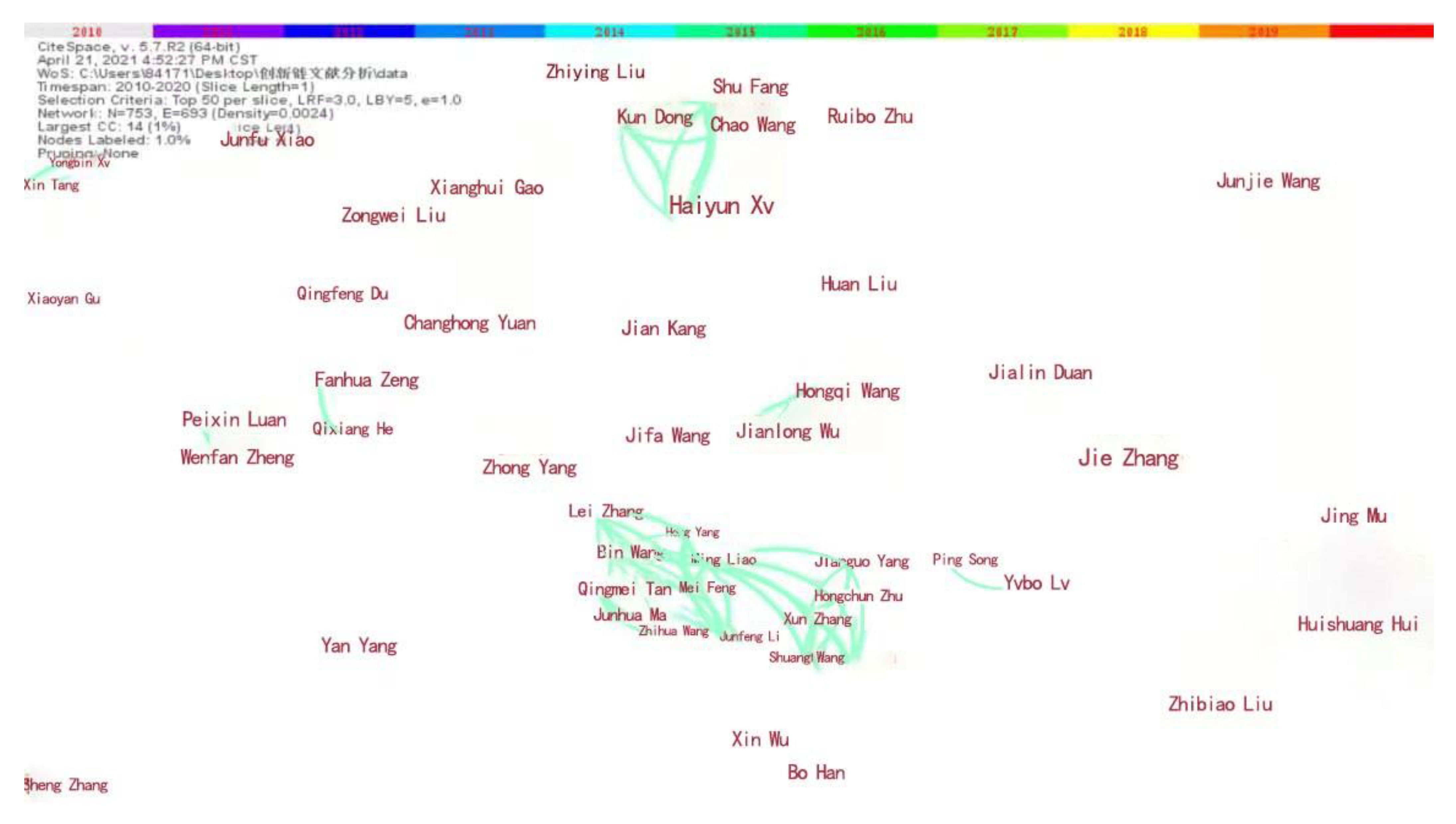
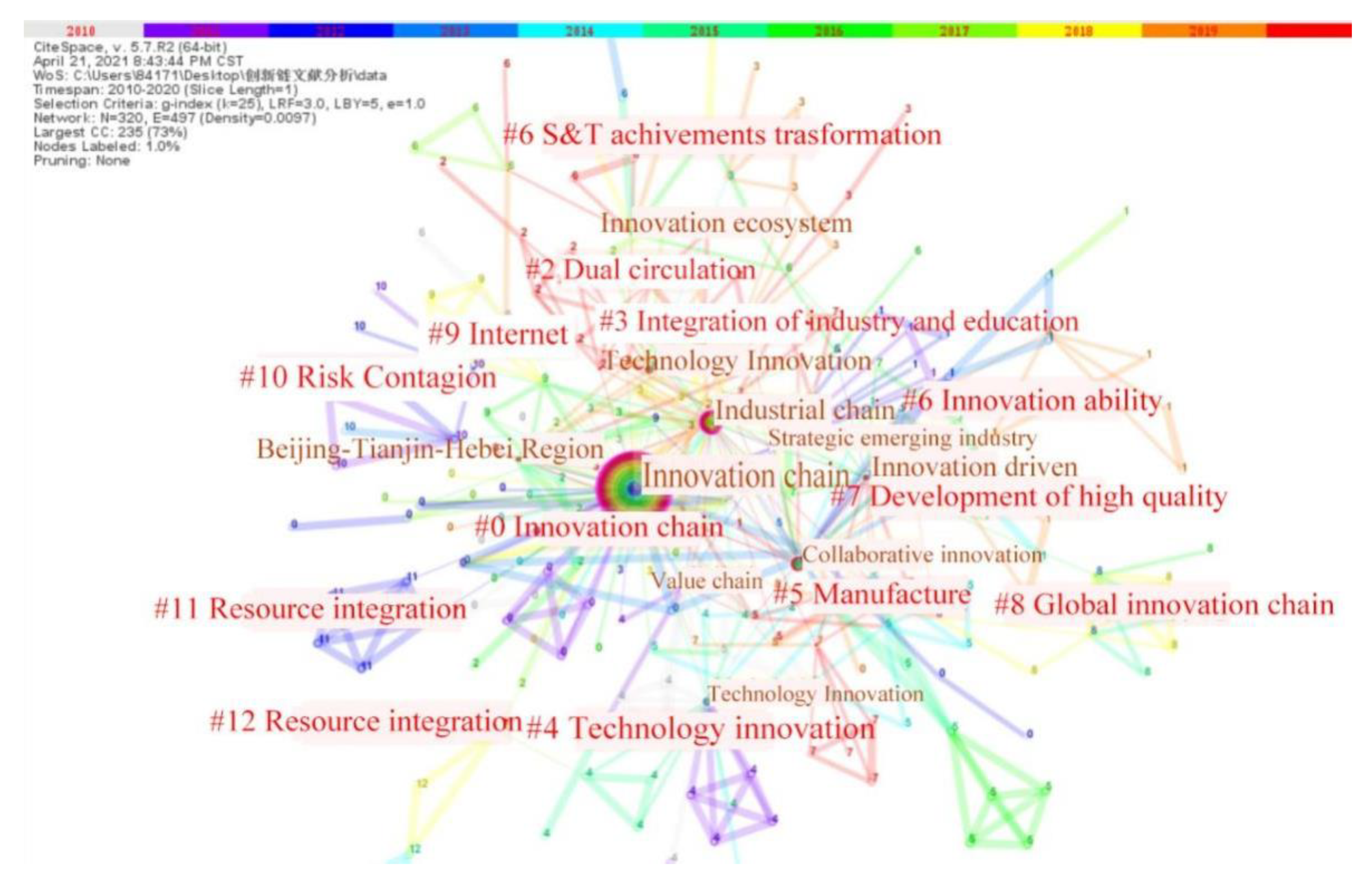

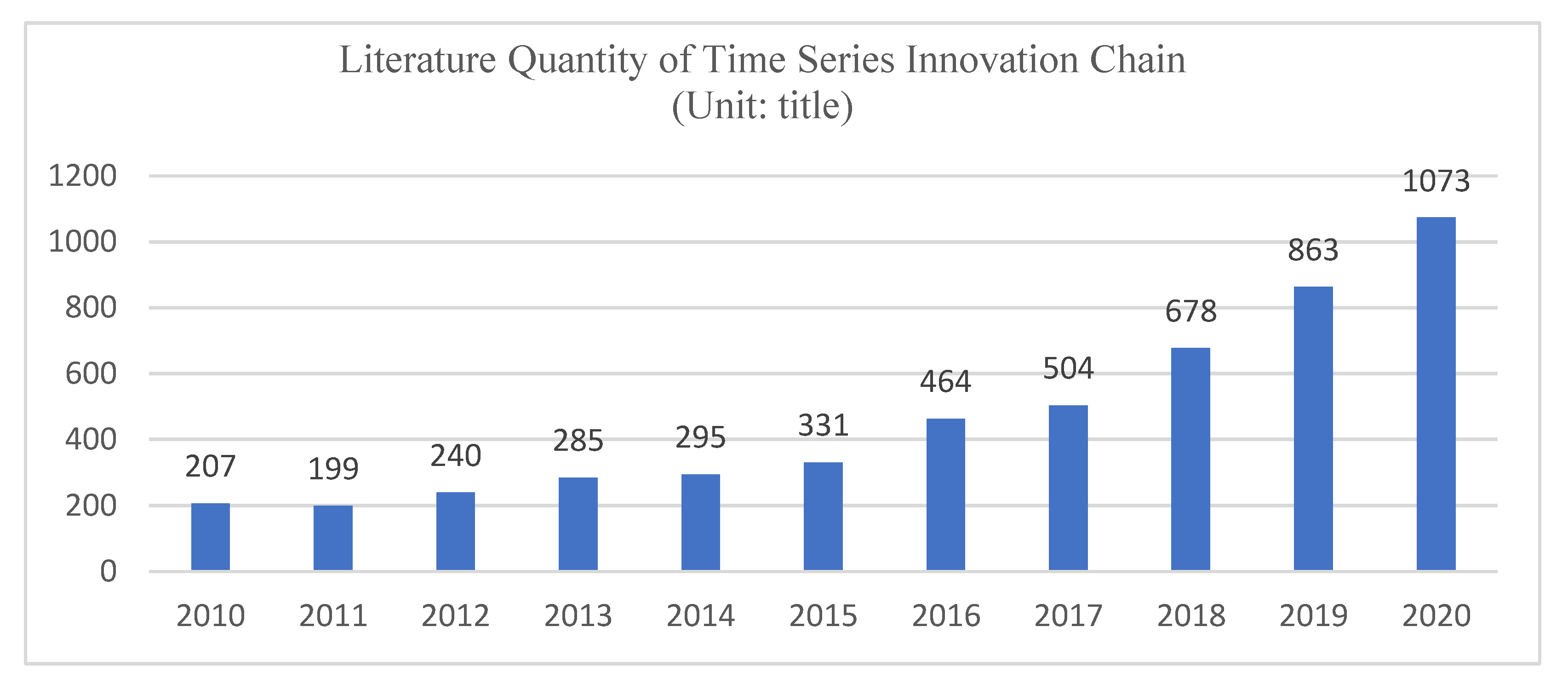
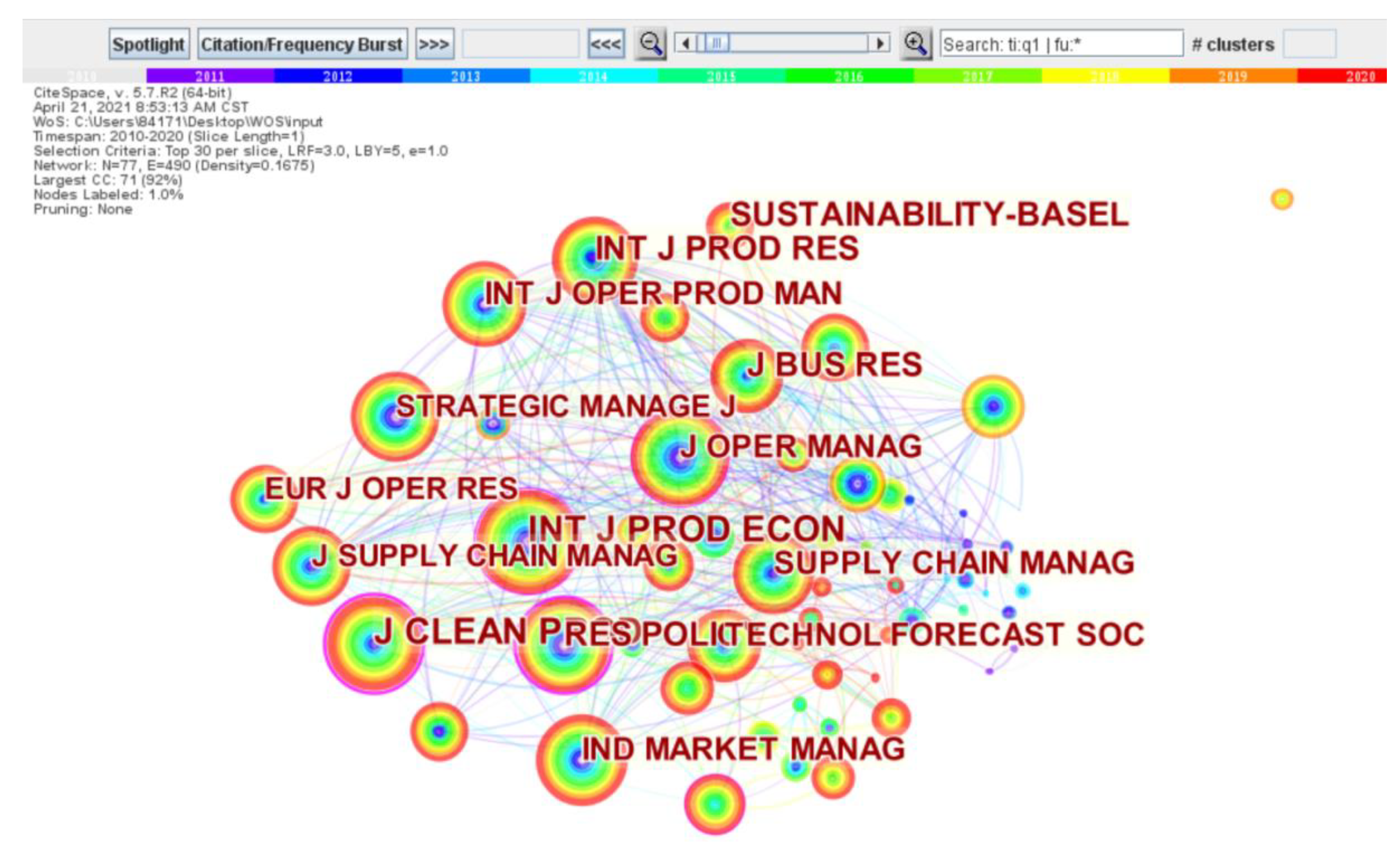
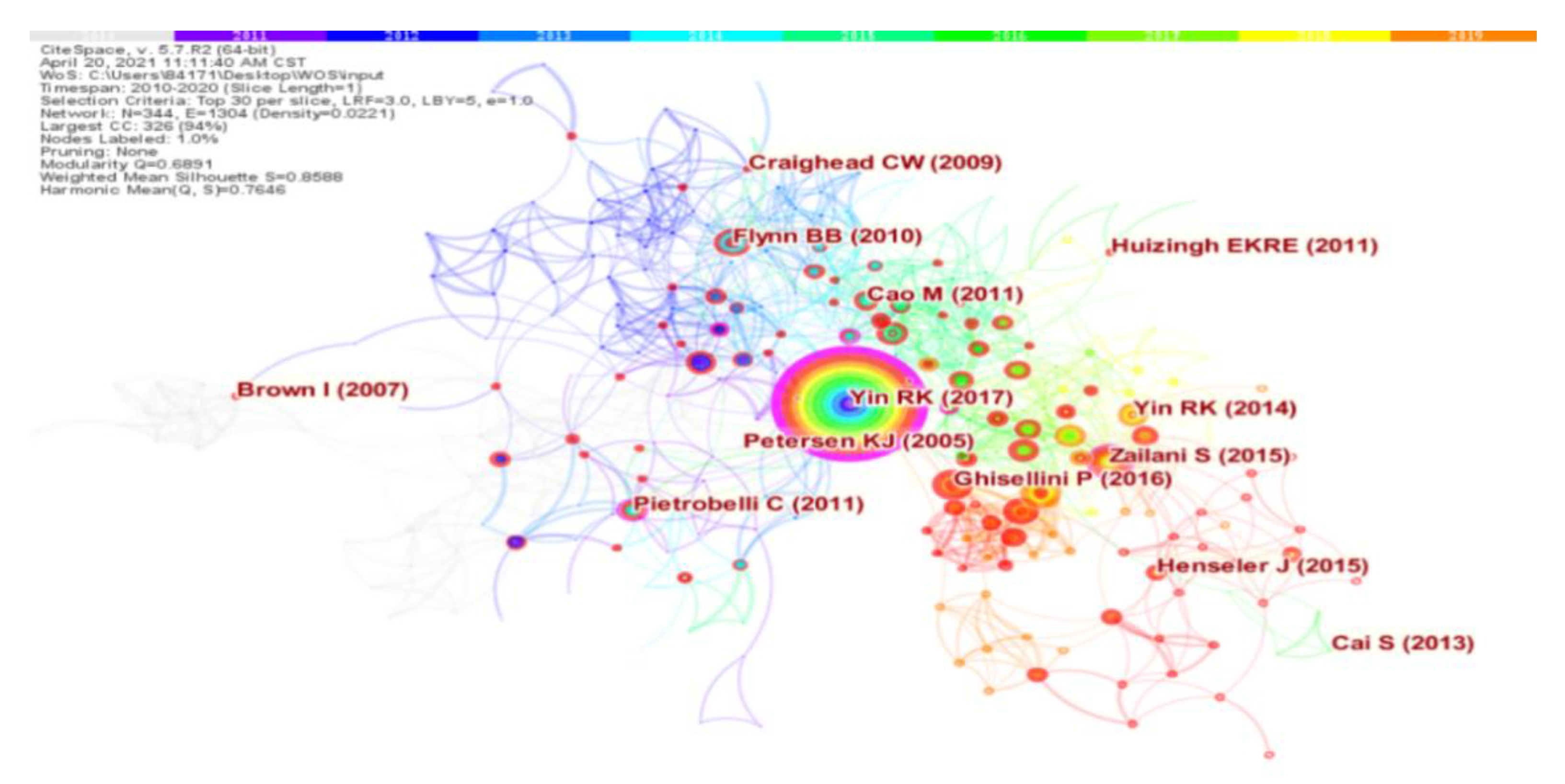


| Time | Threshold | Space | Nodes | Links/All |
|---|---|---|---|---|
| 2010 | Top50 | 69 | 31 | 29/29 |
| 2011 | Top50 | 77 | 37 | 45/46 |
| 2012 | Top50 | 104 | 37 | 45/49 |
| 2013 | Top50 | 73 | 31 | 25/25 |
| 2014 | Top50 | 112 | 40 | 35/35 |
| 2015 | Top50 | 106 | 41 | 45/45 |
| 2016 | Top50 | 181 | 48 | 61/64 |
| 2017 | Top50 | 130 | 43 | 35/40 |
| 2018 | Top50 | 108 | 40 | 46/46 |
| 2019 | Top50 | 212 | 51 | 66/76 |
| 2020 | Top50 | 314 | 63 | 102/104 |
| Time | Threshold | Space | Nodes | Links/All |
|---|---|---|---|---|
| 2010 | Top30 | 4111 | 55 | 165/177 |
| 2011 | Top30 | 4128 | 34 | 59/59 |
| 2012 | Top30 | 5397 | 56 | 168/189 |
| 2013 | Top30 | 6221 | 57 | 171/307 |
| 2014 | Top30 | 6430 | 31 | 79/104 |
| 2015 | Top30 | 7888 | 51 | 153/275 |
| 2016 | Top30 | 11125 | 40 | 112/146 |
| 2017 | Top30 | 13708 | 38 | 114/230 |
| 2018 | Top30 | 18402 | 40 | 120/154 |
| 2019 | Top30 | 22602 | 40 | 120/224 |
| 2020 | Top30 | 33526 | 36 | 108/202 |
| Author | Number | Burst | Grade | Centrality | From Time | Half-Life |
|---|---|---|---|---|---|---|
| Jie Zhang | 10 | 4 | 0 | 2017 | 2.5 | |
| Hongqi Wang | 6 | 9 | 0 | 2012 | 1.5 | |
| Chao Wang | 5 | 2.69 | 5 | 0 | 2017 | −0.5 |
| Haiyun Xu | 5 | 2.69 | 5 | 0 | 2017 | −0.5 |
| Zhibiao Liu | 5 | 2 | 0 | 2012 | 2.5 | |
| Shu Fang | 4 | 3 | 0 | 2017 | 0.5 | |
| Jianlong Wu | 4 | 5 | 0 | 2012 | 1.5 | |
| Ping Li | 4 | 7 | 0 | 2014 | 0.5 | |
| Xuejun Lin | 4 | 4 | 0 | 2018 | −0.5 | |
| Zhong Yang | 4 | 5 | 0 | 2019 | 0.5 |
| Frequency | Burst | Degree | Centrality | Journal | Half-Life | Year |
|---|---|---|---|---|---|---|
| 1469 | 30 | 0.24 | J. CLEAN PROD. | 12.5 | 2006 | |
| 1286 | 34 | 0.11 | INT. J. PROD. ECON. | 10.5 | 2007 | |
| 747 | 30 | 0.08 | INT. J. PROD. RES. | 10.5 | 2007 | |
| 718 | 21 | 0.24 | RES. POLICY | 9.5 | 2007 | |
| 672 | 9 | 0.01 | SUSTAINABILITY-BASEL | 3.5 | 2015 | |
| 666 | 24 | 0.06 | J. BUS. RES. | 12.5 | 2006 | |
| 659 | 18.93 | 35 | 0.17 | J. OPER. MANAG. | 8.5 | 2007 |
| 643 | 13 | 0.04 | TECHNOL. FORECAST. SOC. | 9.5 | 2009 | |
| 606 | 25 | 0.06 | INT. J. OPER. PROD. MAN. | 11.5 | 2006 | |
| 599 | 24 | 0.07 | SUPPLY. CHAIN MANAG. | 8.5 | 2008 |
| Year | Freq | Burst | Degree | Centrality | Author | Half-Life | |
|---|---|---|---|---|---|---|---|
| 2017 | 215 | 42 | 0.78 | Yin RK | −0.5 | 1.0 | |
| 2016 | 59 | 11.74 | 26 | 0.09 | Ghisellini P | 2.5 | 2.83 |
| 2014 | 56 | 15.77 | 22 | 0.06 | Bocken NMP | 3.5 | 2.54 |
| 2015 | 54 | 26 | 0.15 | Zailani S | 3.5 | 1.0 | |
| 2017 | 48 | 12.96 | 21 | 0.01 | Geissdoerfer M | 1.5 | 1.08 |
Publisher’s Note: MDPI stays neutral with regard to jurisdictional claims in published maps and institutional affiliations. |
© 2022 by the authors. Licensee MDPI, Basel, Switzerland. This article is an open access article distributed under the terms and conditions of the Creative Commons Attribution (CC BY) license (https://creativecommons.org/licenses/by/4.0/).
Share and Cite
Gao, Y.; Lin, R.; Lu, Y. A Visualized Analysis of the Research Current Hotspots and Trends on Innovation Chain Based on the Knowledge Map. Sustainability 2022, 14, 1708. https://doi.org/10.3390/su14031708
Gao Y, Lin R, Lu Y. A Visualized Analysis of the Research Current Hotspots and Trends on Innovation Chain Based on the Knowledge Map. Sustainability. 2022; 14(3):1708. https://doi.org/10.3390/su14031708
Chicago/Turabian StyleGao, Yarui, Runhui Lin, and Yanhong Lu. 2022. "A Visualized Analysis of the Research Current Hotspots and Trends on Innovation Chain Based on the Knowledge Map" Sustainability 14, no. 3: 1708. https://doi.org/10.3390/su14031708
APA StyleGao, Y., Lin, R., & Lu, Y. (2022). A Visualized Analysis of the Research Current Hotspots and Trends on Innovation Chain Based on the Knowledge Map. Sustainability, 14(3), 1708. https://doi.org/10.3390/su14031708






